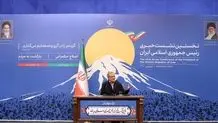Iran’s battle for leadership in global space race
Iran's space projects have picked up speed after a period of stagnation. On Saturday, the country successfully launched a satellite into orbit with a carrier built by Iranian scientists.

MEHR: Iran's space projects have picked up speed after a period of stagnation. On Saturday, the country successfully launched a satellite into orbit with a carrier built by Iranian scientists.
The Chamran-1 satellite weighing 60 kilograms soared into a 550-kilometer orbit aboard the domestically-built Qaem-100 space launch vehicle, the second successful launch in the year. In January, the Sorayya satellite was launched into a 750 km orbit, the highest by the country so far.
A subsidiary of Iran’s Defense Ministry and experts at the Aerospace Research Institute built the Chamran-1 with others to test hardware and software systems for orbital maneuver technology validation.
The satellite soon sent home its first signals, marking Iran’s rise in the ranks of the world’s elite club of nations capable of developing and launching satellites and another giant stride in the country’s civilian space program in spite of Western sanctions.
The space industry is rapidly expanding, becoming a catalyst for development as it creates value for multiple industries and presents solutions to many of the world’s most pressing challenges.
The sector holds significant promise, presenting unparalleled opportunities through generating highly skilled employment, driving economic growth, and spearheading technological advancements.
According to strategy and management consulting firm McKinsey & Company, the global space economy will be worth $1.8 trillion by 2035, up from $630 billion in 2023.
The value estimates for space are similar to those for semiconductors put at $600 billion in 2021 with 6 to 8 percent annual growth into the 2030s and roughly half of the projection for the global payments industry forecast to reach $3.2 trillion in revenues by 2027.
Although currently dominated by key players such as the US and China, the space sector is seeing the emergence of new actors and Iran’s achievements signal a burgeoning presence in the global space arena.
In 2022, the World Population Review Organization (WPR) ranked Iran as the 11th country among 16 nations with complete space launch capabilities. Since then, the successful launch of Sorayya and Chamran-1 as well as the simultaneous deployment of the Mahda, Kayhan-2, and Hatef-1 satellites into space early this year has ushered in a new frontier in Iran’s space exploration.
This is albeit the tirade, harangue, and rant about Iran's space goals – the typical reaction of the Western governments to these launches, as is their view of Iran’s nuclear energy program.
Following the launch of the Chamran-1, a State Department official was quoted as saying that the United States had “long made clear our concern that Iran’s space launch vehicle programs provide a pathway to expand its longer-range missile systems.”
Iran remains unfazed. The space industry development proceeds without fanfare where the news and images of each launch are released with delay and discretion, but everything goes according to plan.
Iran’s Seventh National Development Plan sets out the priority action for the construction of a constellation in space with 30 satellites and completing the country’s national launch base.
Known as the General Soleimani Satellite System, the constellation is intended as a telecommunication system to provide narrowband internet of things (IoT) services. It is part of Iran's ongoing 10-year space program, implemented in January 2023, to turn the country into a regional space power.
The program includes the development of launch infrastructure and ground stations, speeding up the design and construction of telecommunication satellites, the launch of more accurate measurement satellites, and planning to achieve the launch of high-weight cargoes.
Under the plan, Iran should be able to send capsules of one tonne and above with the ability to carry living organisms to a 400-km orbit by the end of the Persian year of 1404 in March 2026.
آخرین اخبار Iran را از طریق این لینک پیگیری کنید.




